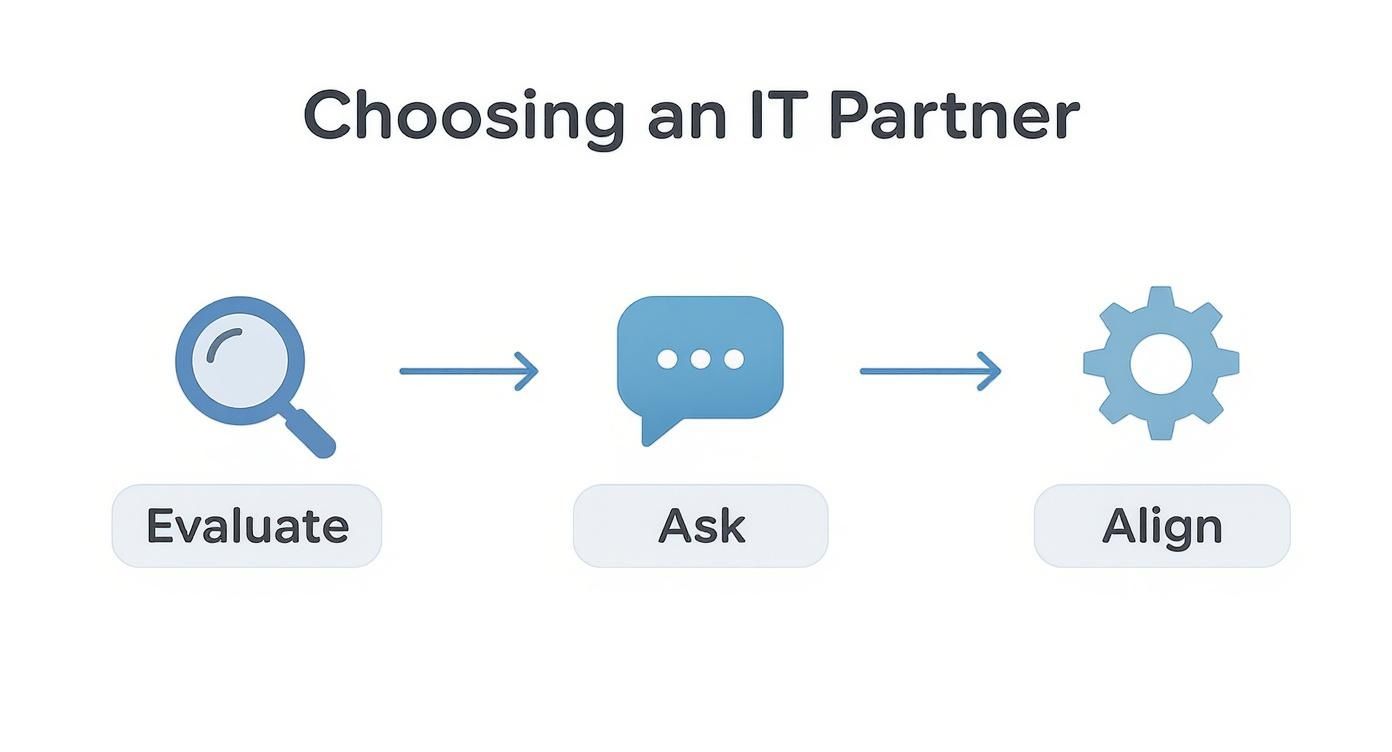
December 14, 2025
Small business it support edmonton: A Guide for Local Business LeadersDiscover small business it support edmonton options with clear pricing, expert guidance, and efficient IT solutions for growth.
Read Full Post%20(1).webp)
Usman Malik
Chief Executive Officer
October 30, 2025

Managed IT support services offer a smarter way for businesses to handle their technology. Instead of reacting to problems as they happen, you outsource your entire IT management to a specialized third-party company known as a Managed Service Provider (MSP). For a predictable monthly fee, they proactively monitor, maintain, and improve your systems, acting as a strategic partner rather than just a repair service.

Think of an in-house IT generalist as a trusted family doctor. They are great for day-to-day check-ups and common issues but can quickly become overwhelmed in a crisis. An MSP, on the other hand, is like a fully equipped hospital. It is staffed 24/7 with a deep bench of specialists—from network engineers to cybersecurity experts—ready for anything from minor glitches to critical emergencies.
This is the fundamental shift we are seeing across Canadian businesses. Companies are moving away from the old, reactive "break-fix" model, where IT help is only called after something has already gone wrong. That outdated approach inevitably leads to unpredictable costs, frustrating downtime, and a constant cycle of putting out fires that distracts you from your core business activities.
Managed IT support is built on a proactive partnership model. An MSP does not just fix broken computers; they become an extension of your team, ensuring your entire technology infrastructure is secure, efficient, and aligned with your business goals. Their primary role is to prevent problems before they start.
By outsourcing IT management, businesses gain access to enterprise-grade expertise and technology that would be prohibitively expensive to build and maintain internally. This levels the playing field, allowing medium-sized organizations to compete more effectively.
This proactive stance means they are always monitoring your systems. Through continuous monitoring, regular maintenance, and layered security measures, an MSP works to prevent disasters instead of just reacting to them.
Partnering with an MSP offers more than just troubleshooting. They provide the complete technology framework your business needs to grow. This typically includes:
Ultimately, managed IT support services transform your technology from a recurring headache into a powerful asset that drives your business forward.

When you partner with a provider for managed IT support services, you receive much more than just on-call technical assistance. You are bringing a dedicated partner on board whose entire function is to keep your operations running smoothly, securely, and efficiently.
A strong managed IT relationship is built on proactive care, not reactive fixes. The goal is not to wait for something to break; it is to prevent problems from ever affecting your business. This forward-thinking approach is what separates modern IT management from the old break-fix model.
Before we explore the core services you should expect, let's quickly compare these two philosophies. Understanding the difference highlights why a proactive approach is so critical for business continuity today.
As the table shows, managed services are designed to be a strategic investment in your business's stability and growth, rather than just an expense you incur when things go wrong.
Imagine a minor server glitch occurs overnight. Without monitoring, it could easily escalate into a full system outage by morning, grinding your operations to a halt. Proactive monitoring is designed to prevent exactly that.
Your MSP will use sophisticated tools to monitor your network, servers, and devices 24/7/365. These systems automatically flag unusual activity, performance dips, or potential hardware failures, allowing technicians to intervene and resolve issues before they cause significant disruption. You can learn more about how this works in our guide on remote monitoring and management.
This constant vigilance is the core of any reputable managed IT support agreement.
Even with the best preventive care, your team will still need assistance from time to time. A responsive, Canada-based helpdesk is non-negotiable, acting as the frontline support to keep your employees productive.
Whether it is a forgotten password, a software bug, or a connection problem, your staff needs fast and friendly solutions. A professional MSP provides multiple ways to get help—phone, email, or a one-click IT support button—ensuring minor technical issues do not escalate into major productivity losses.
What would happen if a fire, flood, or ransomware attack wiped out your company’s data tomorrow? A solid data backup and disaster recovery (BDR) plan is your business's insurance policy against catastrophe, ensuring you can restore operations with minimal disruption.
Your provider will establish automated, regular backups of your critical data, storing them securely both on-site and in the cloud. They will also develop a clear disaster recovery plan and test it periodically to ensure it works when you need it most.
A robust backup and disaster recovery strategy is no longer a luxury—it is a fundamental requirement for business continuity. It ensures that a single event does not threaten your company's existence.
As cyber threats become more sophisticated, a simple firewall is no longer sufficient. A key role of managed IT support services is to build a multi-layered defence to protect your digital assets. This approach creates several barriers an attacker must overcome, making a breach much less likely.
This comprehensive security strategy typically includes:
In Canada, the managed services market is projected to grow at a CAGR of 14.2% from 2025 to 2030, largely driven by the increasing need for advanced security. A reliable MSP will also help you navigate complex regulations. For instance, they can help you understand requirements by referring to resources like a comprehensive HIPAA compliance checklist for healthcare organizations.
Let's move past the technical details. For any business leader, the key question is simple: What is in it for us? The answer involves more than just better technology; it is about tangible results that strengthen your bottom line, boost efficiency, and pave the way for growth.
Partnering with an MSP shifts technology from a reactive expense to a powerful strategic asset. Instead of facing unpredictable repair bills and budgeting challenges, you benefit from a clear, fixed monthly cost. This financial predictability allows you to plan more effectively and allocate resources where they will have the greatest impact.
For most medium-sized businesses, building a comprehensive in-house IT department is unrealistic. Hiring a single senior IT specialist is expensive, and it is impossible for one person to be an expert in everything from network architecture to advanced cybersecurity.
An MSP gives you access to an entire team of certified specialists for a fraction of that cost. You instantly gain expertise in cloud solutions, data security, and compliance without the heavy overhead of salaries, benefits, and ongoing training.
This model levels the playing field, providing you with the same high-calibre IT management and security that larger enterprises rely on. It is a strategic move, and it is one of the key benefits of managed IT services that forward-thinking companies are using to fuel their growth.
Cyber threats are a constant, growing risk for Canadian businesses. A single security breach can lead to devastating financial losses, damage your reputation, and result in legal complications. An MSP partnership fortifies your defences with a multi-layered security strategy that extends far beyond basic antivirus software.
By entrusting your IT to specialists, you are not just outsourcing tasks—you are upgrading your company’s resilience, security posture, and capacity for innovation. It is a strategic investment in long-term stability and growth.
This includes continuous threat monitoring, regular vulnerability scans, and proactive patching to close security gaps before attackers can exploit them. A knowledgeable MSP also helps you navigate the complexities of compliance requirements like PHIPA or PIPEDA, ensuring your operations meet all necessary legal and industry standards. The Canadian IT services market is projected to reach USD 60.08 billion in 2025 and is expected to grow to USD 128.46 billion by 2030, largely fuelled by the rising demand for secure cloud services and compliance expertise.
Perhaps the most powerful benefit is the freedom it gives your internal team. When your staff is not burdened with troubleshooting printer issues or managing software updates, they can dedicate their time and energy to their primary roles—the work that drives your business forward.
This shift creates two significant effects:
Ultimately, partnering with the right MSP for managed IT support services moves your organization from a state of constant IT maintenance to one of continuous improvement and strategic advancement.
Understanding how managed IT services are priced is a crucial first step in finding the right partner. Unlike the unpredictable nature of break-fix IT, managed IT support services are based on clear, structured models. This transparency allows you to budget effectively and align your technology spending directly with your business goals.
The right model depends on your company's specific needs, size, and growth trajectory. Let's examine the most common pricing structures you are likely to encounter.
Most providers offer several ways to work together, each with distinct advantages. To see what this looks like in practice, you can explore pricing models to understand how different providers structure their costs.
Here is a breakdown of the typical options:
Tiered Plans: This is a classic approach. Services are bundled into packages, often named Bronze, Silver, and Gold. The entry-level tier usually covers basics like monitoring and helpdesk support. Higher tiers include more advanced services like enhanced cybersecurity, strategic consulting, and disaster recovery. It is a great fit for businesses that want a straightforward, pre-packaged solution.
Per-User or Per-Device Pricing: As the name suggests, you pay a flat monthly fee for each employee (per-user) or for each computer, server, or tablet (per-device) being managed. This simple approach scales as your team changes, making it ideal for businesses with fluctuating staff numbers.
All-Inclusive: This is the premium option, offering a complete suite of services for one fixed monthly price. It typically covers everything from 24/7 support and security to long-term planning and project work. This model is best for organizations that value total cost predictability and want to eliminate surprise bills.
Each model serves a different purpose. A small business with simple needs might find a tiered plan is just right, while a fast-growing company might prefer the flexibility of a per-user model.
Regardless of the pricing model you choose, the Service Level Agreement (SLA) is the most important document you will sign. The SLA is the official contract that details exactly what services you will receive and the measurable standards your provider must meet. It is your guarantee of quality and accountability.
A solid SLA transforms vague promises into concrete, legally binding commitments. It eliminates ambiguity and sets clear expectations, ensuring you receive the value you are paying for.
An SLA is not just a technical document; it is a business tool. It ensures your IT partner is contractually obligated to deliver the performance, availability, and support your organization needs to thrive.
When reviewing an SLA, look for specific, quantifiable metrics. Vague promises like "fast response times" are a red flag. You need clearly defined key performance indicators (KPIs) that leave no room for excuses.
Key metrics to look for include:
Selecting an MSP for your managed IT support services is a significant decision that extends beyond technology. You are not just hiring a vendor; you are bringing a partner into your business. The right one feels like a natural extension of your team, genuinely invested in your security, efficiency, and future direction. A poor choice can lead to frustration, downtime, and wasted resources.
To make an informed decision, you need a clear plan. This means looking past marketing materials to evaluate a provider's industry experience, track record, and cultural fit. A methodical approach ensures you find a partner who not only has the technical expertise but also truly understands your unique business needs.
First, does a potential IT partner have the technical foundation to manage your infrastructure? Do not just take their word for it—ask for proof. A trustworthy provider will be transparent about their team's qualifications and the security standards they adhere to.
When assessing their technical skills, ask specific questions:
This initial step helps filter out providers who lack the core competencies to manage your IT environment effectively.
Generic, one-size-fits-all IT support is no longer sufficient. Every industry has its own unique challenges, whether it is regulatory compliance, specialized software, or specific operational workflows. A partner who already understands your sector can deliver far more value.
For example, a manufacturing firm needs to secure Operational Technology (OT) on the factory floor, which is entirely different from a healthcare clinic that must adhere to PHIPA compliance to protect sensitive patient data.
A provider with deep industry experience speaks your language. They understand your specific compliance pressures, operational pain points, and growth opportunities, allowing them to offer strategic guidance that goes beyond basic IT maintenance.
Always ask potential partners for case studies or references from other clients in your industry. This is the best way to confirm they have practical experience solving the types of problems your business faces daily.
While technical skills are non-negotiable, the best MSP relationships are built on trust and cultural fit. This is the partner you will call in a crisis and collaborate with on future strategy. You must ensure they align with your company’s values and communication style.
Consider these important, less technical factors:
In Canada, the managed IT support services market is expanding, with providers increasingly using AI to enhance support and infrastructure management. According to Cloudtango.net, this focus on advanced solutions is critical for serving Canadian businesses. Choosing a forward-thinking partner who embraces these advancements is key to keeping your IT modern and effective.
Finding the right MSP is a strategic move that will impact every part of your organization. For smaller companies, understanding how these services can be tailored to their needs is especially important. To learn more, check out our guide on managed IT services for small businesses. By taking the time to properly vet potential partners, you can build a relationship that not only resolves problems but actively helps drive your business forward.
Switching to a new provider for your managed IT support services can feel like a significant change, but a professional MSP ensures the transition is smooth and non-disruptive. A well-structured onboarding process is not about flipping a switch and hoping for the best; it is a carefully planned journey designed to minimize disruption and deliver value from day one.
The entire process is built on clear communication and a genuine effort to understand your business. A great partner does not just install software; they take the time to learn your workflows, identify your challenges, and build a technology roadmap that aligns with your goals. This initial deep dive sets the stage for a strong, long-term partnership.
The process of selecting and integrating a new IT partner involves several careful steps to ensure it is the right fit.

As you can see, a successful relationship begins long before any technical work—it starts with thorough evaluation and strategic alignment.
The journey begins with a comprehensive discovery phase. Think of it as a complete health check for your IT. Your new partner will conduct a detailed audit of your existing infrastructure, examining everything from servers and network hardware to software licenses and security protocols. This is not just about finding problems; it is about understanding what is working, what is not, and where the greatest opportunities for improvement lie.
Based on that assessment, they will develop a strategic plan. This is not a generic template but a custom roadmap tailored specifically for your organization. It clearly outlines the steps, timelines, and resources required for the transition, ensuring everyone is aligned from the start.
A well-defined onboarding plan is the blueprint for a successful IT transition. It transforms a potentially complex process into a series of manageable, transparent steps, eliminating surprises and ensuring alignment with your business objectives from the start.
Once you approve the plan, the implementation phase begins. This is where the technical work happens, such as deploying new security tools, migrating data, or setting up monitoring agents on your systems. A professional MSP will schedule this work carefully, often during off-hours, to minimize any impact on your day-to-day operations.
A critical, yet often overlooked, part of onboarding is user training. New technology is only effective if your team knows how to use it. Your MSP should provide clear, straightforward training sessions to familiarize your employees with new systems or procedures, such as how to submit a support ticket or identify a phishing email.
This focus on your people ensures smooth adoption and maximizes your return on investment.
The final stage of onboarding is the official hand-off to the ongoing, proactive support team. The project team transitions responsibility to the 24/7 support desk, providing them with detailed documentation about your specific environment. From this point on, your MSP is fully responsible for monitoring, maintaining, and optimizing your IT.
This marks the shift from a one-time project to a continuous partnership. Your provider will hold regular strategic reviews to discuss performance, address new challenges, and ensure your technology strategy continues to support your evolving business goals. This proactive management is the core of what makes managed IT support services so valuable.
Deciding to partner with a managed IT support provider is a significant step, and it naturally comes with many questions. Business leaders need to feel confident before handing over control of their critical technology. Let's address some of the most common queries we hear.
Not at all. This is one of the biggest misconceptions we see. Managed IT services are designed to be scalable, giving smaller organizations access to enterprise-level tools and expertise that would be prohibitively expensive to build in-house.
Think of it less as an expense and more as a strategic investment in your security, efficiency, and future growth. It levels the playing field, allowing you to focus your resources on your core business, knowing your technology foundation is solid and professionally managed.
Co-managed IT is a flexible partnership where an MSP works alongside your existing in-house IT team. The goal is not to replace your staff but to supplement their skills and take specific, time-consuming responsibilities off their plate.
For example, an MSP can handle 24/7 network monitoring, manage advanced cybersecurity defences, or take care of day-to-day helpdesk tickets. This collaboration frees up your internal experts to focus on high-value, business-specific projects that drive your company forward.
A co-managed IT partnership gives you the best of both worlds—the institutional knowledge of your internal team combined with the specialized expertise and deep resources of a dedicated MSP.
This approach ensures you have no gaps in your IT coverage while empowering your on-site team to perform at their best.
Any professional MSP will have a structured, transparent onboarding process designed to make the transition as smooth as possible. While the exact timeline can vary based on the complexity of your setup, a typical migration takes between 30 to 90 days.
The entire process is carefully managed to cause minimal disruption to your daily operations. It begins with a thorough assessment of your current environment, moves into detailed strategic planning, and concludes with a phased, carefully executed transition. Clear communication is crucial, so you will always know what is happening and what to expect next.
Quite the opposite. A strong MSP partnership actually gives you more strategic control over your technology. Instead of being bogged down in daily technical issues, you gain a clear, high-level view of your IT performance and security posture.
You will receive straightforward reports and participate in regular strategic reviews to ensure your technology roadmap is perfectly aligned with your business goals. You set the direction, and the MSP handles the expert execution. This provides greater visibility and control over your IT strategy and budget than ever before.
Ready to gain clarity and control over your business technology? CloudOrbis provides proactive, 24/7 managed IT support that lets you focus on growth. Discover how our proven process can strengthen your security and efficiency.

December 14, 2025
Small business it support edmonton: A Guide for Local Business LeadersDiscover small business it support edmonton options with clear pricing, expert guidance, and efficient IT solutions for growth.
Read Full Post
December 13, 2025
Data Recovery Calgary Alberta: Your Guide to Restoring Critical Business FilesNeed data recovery calgary alberta? Get trusted Calgary-based experts, clear quotes, fast turnaround, and secure restoration of critical files.
Read Full Post
December 12, 2025
IT Support for Private Career Colleges in Alberta: A Complete GuideA practical guide to IT support for private career colleges in Alberta. Learn to navigate compliance, security, and technology for your institution's success.
Read Full Post